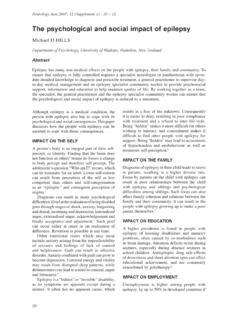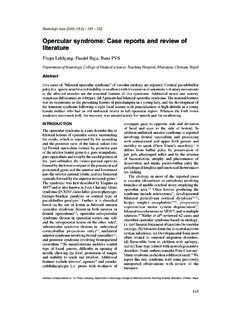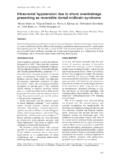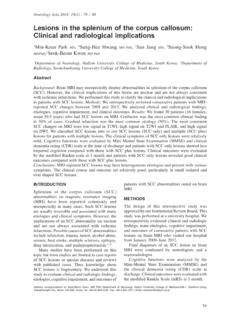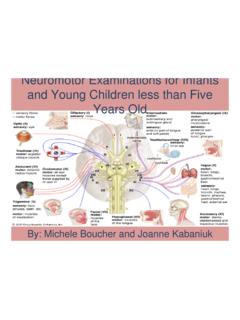Transcription of Reference values for nerve function assessments …
1 39 Reference values for nerve function assessments among a study population in northern India - III: Sensory and motor nerve McKnight, 2PG Nicholls, 3 Das Loretta, 4KV Desikan, 1 DNJ Lockwood, 5EP Wilder-Smith, 6WH van Brakel 1 London School of Hygiene and Tropical Medicine, London, UK; 2 School of Health Sciences, University of Southampton, Southampton, UK; 3 The Leprosy Mission India, PO Naini, Allahabad, UP, India; 4 LEPRA India, Hyderabad, India; 5 Division of Neurology, National University Hospital, Singapore; 6 Royal Tropical Institute (KIT), Amsterdam, The NetherlandsAbstract Objective: To identify Reference values for normal sensory and motor nerve conduction in upper and lower limb peripheral nerves in a study population in India.
2 The work was carried out in advance of the INFIR Cohort Study, a prospective study of individuals with newly diagnosed multibacillary MB leprosy, the objective being to identify early changes in nerve function predictive of new onset impairment and reactions. Methods: We assessed sensory nerve conduction in bilateral ulnar, median, radial cutaneous and sural nerves and motor nerve conduction in distal and proximal sites in bilateral ulnar, median and peroneal nerves among 315 healthy subjects. After adjustment for skin temperature and removal of outliers Reference values were computed using regression analysis of log-transformed data. The analysis and resulting Reference values were stratifi ed by age and sex and based on the appropriate 5th or 95th percentiles.
3 Results: Presented here are Reference values for sensory nerve conduction velocity (SNCV), sensory nerve action potential (SNAP) amplitude and latency. Also for motor nerve conduction velocity (MNCV) and compound motor action potential (CMAP) amplitude at proximal sites and for amplitude and latency at distal sites. In each case percentiles are given by sex within four 10 year age bands. For males aged 55 years old, the Reference value for ulnar SNCV was m/sec and SNAP amplitude was V. Ulnar MNCV at the proximal site in the elbow was m/sec and CMAP amplitude mV and at distal sites in the wrist the amplitude was mV and latency msec. In the leprosy-affected cohort, the most common and therefore potentially the earliest impairment, is found in sensory nerve conduction amplitude of the sural nerve .
4 Neurology Asia 2010; 15(1) : 39 54 Address correspondence to: Jason McKnight, London School of Hygiene and Tropical Medicine, Keppel St, London WC1E 7HT, UK. Email: of motor and sensory nerve conduction is a proven diagnostic tool in the testing of peripheral nerve Electrophysiological assessment of sensory nerve action potential (SNAP), compound motor action potential (CMAP) amplitudes, sensory nerve conduction velocity (SNCV) and motor nerve conduction velocity (MNCV) help to characterise and quantify the sensory and motor functions in the large myelinated fi bres of peripheral nerves. Reference values are used to defi ne the limits of normal function , with test values outside the range suggesting the presence of some form of neuropathy.
5 Small fi bre function is separately assessed with tests of pain, thermal perception, sweat or vasomotor function . Previous studies have reported differences in function related to ethnicity and demographic The present paper is part of a series reporting normal Reference values for a study population in northern India in advance of a prospective cohort study or individuals newly diagnosed with multibacillary leprosy. This is the fi rst large study to make prospective assessments of vibration perception, warm and cold sensation and nerve conduction in order to identify the earliest available indicator of changes in nerve function related to leprosy reactions.
6 Since loss of sensation in leprosy brings an increased risk of secondary impairments, identifying the early indicators of nerve involvement is a primary concern. While the TRIPOD study5 suggested that prophylactic treatment of early involvement of large myelinated touch fi bers detected by Neurology AsiaApril 201040monofi lament was not appropriate, alternative forms of nerve function assessment may detect other forms of nerve involvement, including those functions fi rst affected. The research was centred on the specialist leprosy referral centres in Naini and Faizabad, Uttar Pradesh, northern India, run by The Leprosy Mission International. Early fi ndings of the Cohort Study have already been METHODS Subject selection and sample sizeDetermination of the limits of normal function requires the collection and analysis of data from healthy subjects without a neurological condition drawn from a defi ned population group.
7 In order to achieve a close match with individuals recruited to the cohort study we recruited subjects from among the healthy relatives accompanying individuals attending general and dermatology outpatient clinics at the two participating centres, applying inclusion and exclusion criteria as follows:Inclusion criteria: Individuals were selected to obtain an equal number of male and female study subjects and by age group. In order to ensure the closest possible match with individuals recruited to the subsequent Cohort Study, equal numbers of subjects were included within four age bands up to 60 years, the maximum age for recruitment. Exclusion criteria: Since the diagnosis of leprosy can only be made on clinical grounds all subjects were screened by an experienced leprologist leading to the exclusion of anyone exhibiting any clinical signs and symptoms of leprosy.
8 Subjects with any known neurological disorder, previous contact with leprosy or a history of diabetes were also excluded. Individuals aged above 60 years or those less than 10 years were excluded. nerve conduction testing was concurrent with the parallel studies focussing on thermal sensation and vibration perception. Some subjects were involved in more than one study. To ensure adequate precision we studied 40 subjects within each of the four age groups for men and for women. The overall target for the number of normal subjects was therefore 320, equal numbers to be recruited in each and proceduresThe equipment used was a Neurocare 2000 nerve conduction system supplied by BioTech (India).
9 Data was saved in a standard Microsoft Access database. All testing was conducted in air-conditioned rooms with the temperature maintained in the range between 20 and 26 C. Skin temperatures were recorded using a Testo Quicktemp electronic surface thermometer. Protocol for testing and data recordingThe nerves and test sites matched those used in the Cohort Study. Testing was done bilaterally on the cutaneous area of fi ve nerves that are affected during leprosy neuropathy. For antidromic sensory conduction in the upper limbs, the ulnar and median nerves supplying digits 5 and 2 respectively, and the radial cutaneous nerve at the wrist, were studied. For the lower limb the sural nerve was studied behind the lateral malleolus.
10 Action potentials were recorded at a standard distance of 14 cm in all nerves. Sensory testing produced assessments of SNCV and SNAP amplitude and latency for each nerve . Motor testing produced assessments of MNCV and CMAP amplitude and latency at proximal sites and CMAP amplitude and latency at distal sites for bilateral ulnar, median and peroneal nerves. All the neurophysiological tests were according to a standardised set-up with distances specifi ed. Skin temperatures were measured electronically at wrist and ankle bilaterally. Further details of the study design are available in earlier nerve conduction testing was undertaken by the team of physiotherapists, who were also responsible for vibration perception and thermal threshold testing.

